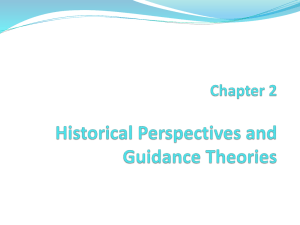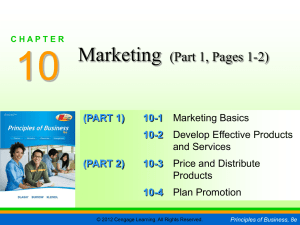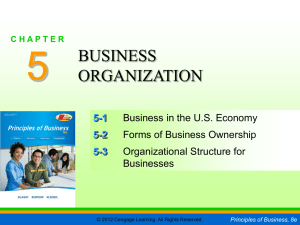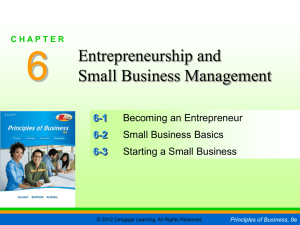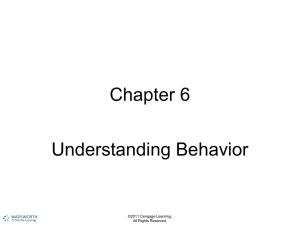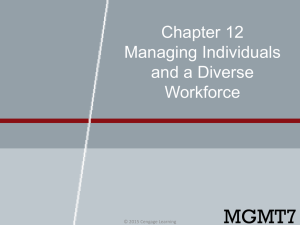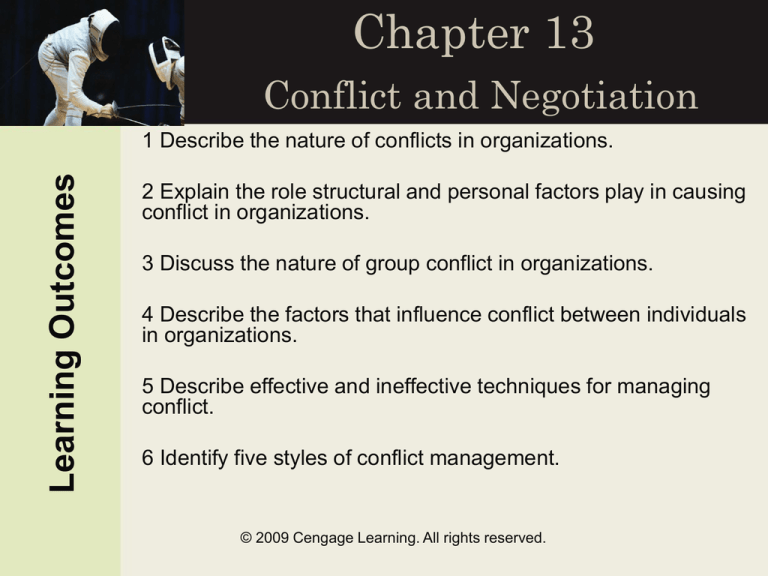
Chapter 13
Conflict and Negotiation
Learning Outcomes
1 Describe the nature of conflicts in organizations.
2 Explain the role structural and personal factors play in causing
conflict in organizations.
3 Discuss the nature of group conflict in organizations.
4 Describe the factors that influence conflict between individuals
in organizations.
5 Describe effective and ineffective techniques for managing
conflict.
6 Identify five styles of conflict management.
© 2009 Cengage Learning. All rights reserved.
1
Learning Outcome
Describe the nature of conflicts in
organizations.
© 2009 Cengage Learning. All rights reserved.
Nature of Organizational
Conflict
Conflict – any situation in which
incompatible goals, attitudes, emotions,
or behaviors lead to disagreement or
opposition between two or more parties
Functional Conflict – a healthy,
constructive disagreement between two
or more people
Dysfunctional Conflict – an unhealthy,
destructive disagreement between two
or more people
© 2009 Cengage Learning. All rights reserved.
Emotional Intelligence (EI)
Emotional intelligence – Amanda
• the power to control one’s emotions
• perceive emotions in others
• adapt to change
• manage adversity
© 2009 Cengage Learning. All rights reserved.
Importance of Conflict Management
Skills-Amanda
“As managers we spend
about 21% of our time
dealing with conflict.”
• Conflict management skills predict
managerial success
• High Emotional Intelligence (EI) needed
to manage conflict
• EI is valid across cultures
© 2009 Cengage Learning. All rights reserved.
Consequences of Conflict-Xiaohan
Positive
Consequences
Leads to new ideas
Stimulates creativity
Motivates change
Promotes organizational
vitality
Helps individuals and groups
establish identities
Serves as a safety valve to
indicate problems
Negative
Consequences
Diverts energy from work
Threatens psychological
well-being
Wastes resources
Creates a negative climate
Breaks down group cohesion
Can increase hostility and
aggressive behaviors
Diagnosing Conflict-Tessa
• Examine the issue
• Analyze the context
• Know the parties involved
© 2009 Cengage Learning. All rights reserved.
Questions to Use When
Diagnosing Conflict-Tessa
Yes
Are the parties approaching the conflict from a hostile
standpoint?
Is the outcome likely to be a negative one for the
organization?
Do the potential losses of the parties exceed any potential
gains?
Is energy being diverted from goal accomplishment?
© 2009 Cengage Learning. All rights reserved.
No
2
Learning Outcome
Explain the role structural and personal
factors play in causing conflict in
organizations.
© 2009 Cengage Learning. All rights reserved.
Causes of Conflict in OrganizationsJustin
Structural Factors
• Specialization
• Interdependence
• Common resources
• Goal differences
• Authority relationships
• Status inconsistencies
• Jurisdictional ambiguities
Personal Factors
• Skills and abilities
• Personalities
• Perceptions
• Values and ethics
• Emotions
• Communication barriers
• Cultural differences
Beyond the Book:
“Bully” Gates?
Bill Gates has been known to berate
employees for unsatisfactory
performance, even insulting and
yelling at them.
Is Gates a bully, or does he just
hate incompetence?
© 2009 Cengage Learning. All rights reserved.
Globalization and Conflict-Richard
Cultural differences and individual differences
increase the potential
for conflict
© 2009 Cengage Learning. All rights reserved.
3
Learning Outcome
Discuss the nature of group conflict in
organizations.
© 2009 Cengage Learning. All rights reserved.
Forms of Conflict in OrganizationsTyson
Interorganizational Conflict – conflict that
occurs between two or more
organizations
Intergroup Conflict – conflict that occurs
between groups or teams in an
organization
Intragroup Conflict – conflict that occurs
within groups or teams
© 2009 Cengage Learning. All rights reserved.
Forms of Conflict in OrganizationsKaylee
Interpersonal Conflict – conflict that
occurs between two or more individuals
Intrapersonal Conflict – conflict that
occurs within an individual
© 2009 Cengage Learning. All rights reserved.
Managing Interpersonal Conflict-Kellie
• Understand power networks
• Recognize defense mechanisms
• Develop strategies to deal with
difficult people
© 2009 Cengage Learning. All rights reserved.
Beyond the Book:
Under-the-Table Torment
Public humiliation in the corporate
world has taken a back seat to more
subtle personal jabs.
Overt office conflict is more likely
to be noticed as such, so
antagonistic coworkers only try
what they think they can get away
with.
© 2009 Cengage Learning. All rights reserved.
4
Learning Outcome
Describe the factors that influence
conflict between individuals in
organizations.
© 2009 Cengage Learning. All rights reserved.
Forms of
Intrapersonal Conflict-Ben K.
Interrole Conflict – a person’s experience of
conflict among the multiple roles in his/her life
Intrarole Conflict – conflict that occurs within a
single role, such as when a person receives
conflicting messages from role senders about
how to perform a certain role
Person–role Conflict – conflict that occurs when
an individual is expected to perform behaviors
in a certain role that conflict with his/her
personal values
© 2009 Cengage Learning. All rights reserved.
[Resolving Intrapersonal Conflict-Karla]
• Use self-analysis
• Diagnose the situation:
• Ask if the organization’s values
match your own, and
• Ask role senders what is expected
• Use political skills to buffer
negative effects of role conflict
stress
© 2009 Cengage Learning. All rights reserved.
An Organizational Member’s Role SetHillary
Outside the
organization
Client
Inside the organization
Supervisor
Focal
Role
Supplier
Potential
employee
Employee
1
Employee
2
Boundary of the organization
Employee
3
Superior
Superior
role
senders
Colleague
Peer
role
senders
Employee’s
colleagues
Employee
role
senders
SOURCE: J. C. Quick, J. D. Quick, D. L. Nelson, & J. J. Hurrell, Jr. Preventative Stress Management in Organizations, 1997. Copyright © 1997 by the American
Psychological Association. Reprinted by permission.
Power Relationships in OrganizationsKrystle
Types of Power
Relationships
Equal vs. equal
Behavioral Tendencies
and Problems
Suboptimization
Competition
Covert fighting
Constant friction
Examples of
Interventions
Define demarcation lines
Integrate units
Teach negotiating skills
High vs. low
Control vs. autonomy
Resistance to change
Motivation problems
Bureaucratize power
through rules
Use a different leadership
style
High vs. middle
vs. low
Role conflict, role
ambiguity, stress
Concessions
Doubletalk
Use of sanctions and
rewards
Improve communication
Clarify tasks
Teach power strategies
SOURCE: W. F. G. Mastenbroek, Conflict Management and
Organizational Development, 1987. Copyright John Wiley & Sons
Limited. Reproduced with permission.
Aggressive (Defense) MechanismsZach
Fixation – an individual keeps up a
dysfunctional behavior that obviously
will not solve the conflict
Displacement – an individual directs his
or her anger toward someone who is
not the source of the conflict
Negativism – a person responds with
pessimism to any attempt at solving a
problem
© 2009 Cengage Learning. All rights reserved.
Compromise (Defense) MechanismsBen M
Compensation – an individual attempts to make
up for a negative situation by devoting
himself/herself to another pursuit with increased
vigor
Identification – an individual patterns his or her
behavior after another’s
Rationalization – a compromise mechanism
characterized by trying to justify one’s behavior
by constructing bogus reasons for it
© 2009 Cengage Learning. All rights reserved.
Withdrawal (Defense) MechanismsKyle M
Flight/Withdrawal – entails physically
escaping a conflict (flight) or
psychologically escaping (withdrawal)
Conversion – emotional conflicts are
expressed in physical symptoms
Fantasy – provides an escape from a
conflict through daydreaming
© 2009 Cengage Learning. All rights reserved.
5
Learning Outcome
Describe effective and ineffective
techniques for managing conflict.
© 2009 Cengage Learning. All rights reserved.
Win–Lose vs. Win–Win StrategiesKyle P
Strategy
Dept. A Dept. B Organization
Competitive
Cooperative
Lose
Lose
Win
Win–
Lose
Win
Lose
Win–
© 2009 Cengage Learning. All rights reserved.
Lose
Lose
Lose
Win
Ineffective Techniques for
Dealing with Conflict-Dillin
Nonaction
Character
Assassination
Secrecy
Conflict
Due Process
Nonaction
Administrative
Orbiting
© 2009 Cengage Learning. All rights reserved.
Beyond the Book:
Looking for Trouble
A South Carolina woman on
probation signed a court document
with instructions as to what body
part the judge could kiss. The
judge rewarded her with an
additional 90 days of probation.
The lesson: considering the consequences of your words can avoid
needless conflict and negative consequences.
© 2009 Cengage Learning. All rights reserved.
Effective Techniques for
Dealing with Conflict-Robin
Superordinate Goals
Confronting
and
Negotiating
Changing
Structure
Conflict
Expanding
Resources
Changing
Personnel
© 2009 Cengage Learning. All rights reserved.
Negotiation
a joint process of finding a mutually
acceptable solution to a complex conflict
© 2009 Cengage Learning. All rights reserved.
Negotiation-Katie
•
•
•
•
Two or more people involved
Conflict of interest exists
Willing to negotiate for a better outcome
Parties prefer to work together
© 2009 Cengage Learning. All rights reserved.
Approaches to Negotiation-Miles
Distributive Bargaining –
the goals of the parties are
in conflict, and each party
seeks to maximize its
resources
© 2009 Cengage Learning. All rights reserved.
Approaches to Negotiation-Miles
Integrative Negotiation –
focuses on the merits of the
issues and seeks a win–win
solution
© 2009 Cengage Learning. All rights reserved.
6
Learning Outcome
Identify five styles of conflict
management.
© 2009 Cengage Learning. All rights reserved.
Conflict Management Styles-Evan
Avoiding – deliberate decision to take no
action on a conflict or to stay out of a conflict
Accommodating – concern that the other
party’s goals be met but relatively
unconcerned with getting own way
Competing – satisfying own interests; willing to
do so at other party’s expense
© 2009 Cengage Learning. All rights reserved.
Conflict Management Styles-Evan
Compromising –
each party
gives up
something to
reach a solution
Collaborating –
arriving at a
solution
agreeable to all
through open
and thorough
discussion
© 2009 Cengage Learning. All rights reserved.
Conflict Management Styles-Evan
Assertive
Competing
Collaborating
Assertiveness
(Desire to satisfy one’s
own concerns)
Unassertive
Compromising
Avoiding
Accommodating
Uncooperative
Cooperative
Cooperativeness
(Desire to satisfy another’s concerns)
SOURCE: K. W. Thomas, “Conflict and Conflict Management,” in M. D. Dunnette, Handbook of Industrial and Organizational Psychology, (Chicago: Rand McNally,
1976), 900. Used with permission of M. D. Dunnette.
Creating a
Conflict-Positive OrganizationLinda
Value diversity
and confront
differences
Take stock to
reward success
and learn from
mistakes
Conflict
Positive
Seek mutual
benefits, and unite
behind
cooperative goals
Empower employees
to feel confident
and skillful
© 2009 Cengage Learning. All rights reserved.
3 Organizational
Views of Conflict
Competitive
conflict
Belittle
differences
Suspect
Seek
win–lose
situation
Blame
SOURCE: The Conflict-Positive Organization by Tjsovold, © 1991. Reprinted by permission of Prentice-Hall, Inc., Upper Saddle River, N.J.
© 2009 Cengage Learning. All rights reserved.
3 Organizational
Views of Conflict
Avoidance of
conflict
Evade
differences
Despair
Reduce
risks
Withdraw
SOURCE: The Conflict-Positive Organization by Tjsovold, © 1991. Reprinted by permission of Prentice-Hall, Inc., Upper Saddle River, N.J.
© 2009 Cengage Learning. All rights reserved.
3 Organizational
Views of Conflict
Positive
conflict
Value
diversity
Take
Stock
Seek
mutual
benefit
Empower
SOURCE: The Conflict-Positive Organization by Tjsovold, © 1991. Reprinted by permission of Prentice-Hall, Inc., Upper Saddle River, N.J.
© 2009 Cengage Learning. All rights reserved.
Conflict Management Tools
© 2009 Cengage Learning. All rights reserved.

